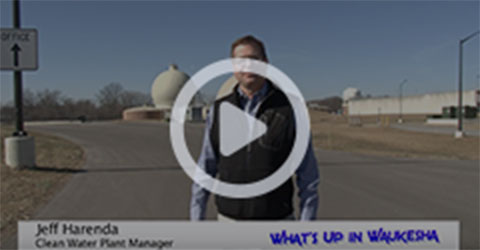City of Waukesha’s Clean Water Plant
The Waukesha clean water treatment plant treats an average of 10 to 12 million gallons a day, although it’s capable of handling an average of 18.5 million gallons a day and a peak flow of 23 million gallons a day.
It’s a big and important undertaking. Waukesha has over 260 miles of sanitary sewer pipes that carry wastewater to the plant. The pipes range from 8 to 72 inches in diameter. They’re cleaned at least yearly — more often if necessary.
Where does the water you use go?
An average household of four uses roughly 260 gallons of water each day. Have you ever wondered where all that water goes after it is used? Wastewater treatment is an immense and crucial part of healthy, vital communities and the City of Waukesha goes above and beyond many by providing advanced levels of treatment to make sure water is returned to the environment safely.
Outlined below is the impressive four step process the Clean Water Plant uses to handle this immensely important undertaking.
PRELIMINARY TREATMENT
Begins when the wastewater arrives at the facilityThe goal is to immediately remove as much inorganic matter as possible. So the water first passes through a bar screen to remove roots, rocks, and other large objects. Next, a finer screen removes rags, plastic, and some forms of paper. Then smaller particles like sand, pebbles, and seeds are eliminated using a grit chamber, which slows the flow, allowing grit to drop to the bottom and be removed.
PRIMARY TREATMENT
After grit removal, primary treatment begins.SECONDARY TREATMENT
During this step of the process, the microorganisms feed on the organic waste.Next, the treated wastewater moves to final clarifiers to separate the activated sludge floc from the water. The sludge is divided in two parts. One part, the return activated sludge, is sent back to the splitter box to provide the microorganisms to treat more wastewater. The second portion is sent to a thickener as waste activated sludge.
TERTIARY TREATMENT
That’s where most wastewater treatment processes end. But before Waukesha water is discharged into the river, it undergoes a third, or tertiary, treatment.This includes phosphorus removal to prevent the growth of algae and vegetation. Sand filters remove all but the finest solids and bacteria. Any remaining bacteria or pathogens are then rendered harmless through exposure to ultraviolet light. Before discharging to the river, the water is aerated to achieve proper oxygen levels.
To learn more about Waukesha’s Clean Water Plant, here are two videos you can view:
Wastewater treatment produces several types of solids. Biosolids (also referred to as sludge) are separated out for further processing. Other solids are sent to a licensed landfill site for disposal.
Waste-activated sludge is biodegraded, dewatered and then stored until spring or fall, when it is scattered in a thin layer over approved agricultural fields and tilled underground within six hours of application to enrich the soil.
Although the process is complex, Waukesha’s Clean Water Plant is highly efficient and successful at protecting the quality of our water resources.

